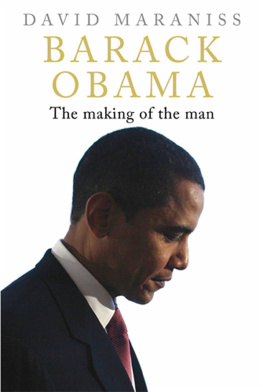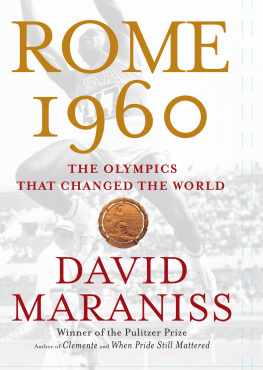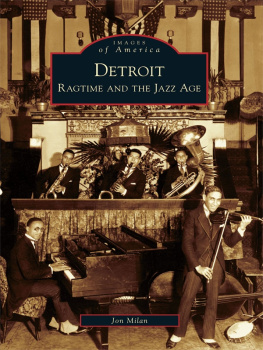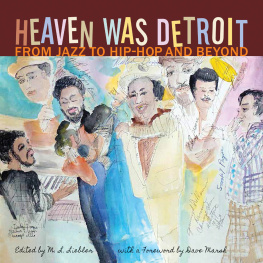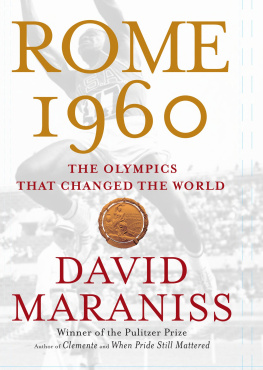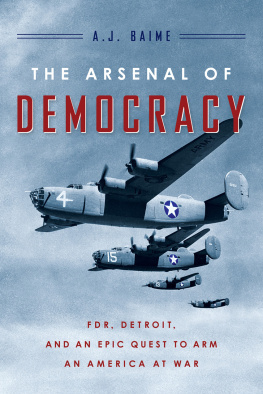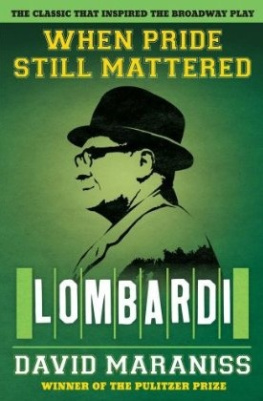Thank you for downloading this Simon & Schuster eBook.
Join our mailing list and get updates on new releases, deals, bonus content and other great books from Simon & Schuster.
C LICK H ERE T O S IGN U P
or visit us online to sign up at
eBookNews.SimonandSchuster.com
We hope you enjoyed reading this Simon & Schuster eBook.
Join our mailing list and get updates on new releases, deals, bonus content and other great books from Simon & Schuster.
C LICK H ERE T O S IGN U P
or visit us online to sign up at
eBookNews.SimonandSchuster.com
ALSO BY DAVID MARANISS
Barack Obama:
The Story
Into the Story:
A Writers Journey through Life, Politics, Sports and Loss
Rome 1960:
The Summer Olympics That Stirred the World
Clemente:
The Passion and Grace of Baseballs Last Hero
They Marched into Sunlight:
War and Peace, Vietnam and America, October 1967
When Pride Still Mattered:
The Life of Vince Lombardi
The Clinton Enigma:
A Four and a Half Minute Speech Reveals This Presidents Entire Life
First in His Class:
A Biography of Bill Clinton
The Prince of Tennessee:
Al Gore Meets His Fate (with Ellen Nakashima)
Tell Newt to Shut Up! (with Michael Weisskopf)

Simon & Schuster
1230 Avenue of the Americas
New York, NY 10020
www.SimonandSchuster.com
Copyright 2015 by David Maraniss
All rights reserved, including the right to reproduce this book or portions thereof in any form whatsoever. For information address Simon & Schuster Subsidiary Rights Department, 1230 Avenue of the Americas, New York, NY 10020
First Simon & Schuster hardcover edition September 2015
SIMON & SCHUSTER and colophon are registered trademarks of Simon & Schuster, Inc.
For information about special discounts for bulk purchases, please contact Simon & Schuster Special Sales at 1-866-506-1949 or
The Simon & Schuster Speakers Bureau can bring authors to your live event. For more information or to book an event contact the Simon & Schuster Speakers Bureau at 1-866-248-3049 or visit our website at www.simonspeakers.com.
Interior design by Joy OMeara
Maps by Gene Thorp
Library of Congress Cataloging-in-Publication Data.
Maraniss, David.
Once in a great city : a Detroit story / David Maraniss.
pagescm
Includes bibliographical references and index.
1.Detroit (Mich.)History20th century.I.Title.
F574.D457M352015
977.4'34dc23
ISBN 978-1-4767-4838-2
ISBN 978-1-4767-4840-5 (ebook)
Photo insert credits can be found on .
To the people of Detroit
CONTENTS
AUTHORS NOTE
In a sense this book had been in the works since the summer of 1949, when I was born at Womens Hospital in Detroit, but the inspiration came on Super Bowl Sunday in early February 2011 as I watched the title game at a bar in midtown Manhattan. At halftime, with the Green Bay Packers on their way to victory, I was caught in the swirl of emotions of an anxious fan and barely paying attention to the studio commentary and commercials. Then I looked up at the screen to see a green freeway sign that said DETROIT. A series of images flashed by in rhythm to a pulsing sound track. Wintry landscape. Smokestacks. Abandoned factories. World-class architecture. The Joe Louis Fist. The Diego Rivera mural Detroit Industry . Ice skaters gliding, runners in hooded sweatshirts pounding onward, determined to keep going. The giant sculpture The Spirit of Detroit . A narrator, his voice confidently embracing the scene: Now were from America. But this isnt New York City, or the Windy City, or Sin City, and it certainly isnt the Emerald City .
The camera swooped inside a Chrysler 200, leathered warm and black, and there was Marshall Mathers, the singer known as Eminem, cruising down Woodward Avenue in his hometown, city of my birth, the back beat hypnotic as he approached the Fox Theater and stepped from the sedan and past the golden marquee and walked down the aisle toward a black gospel choir, robed in red and black, their voices rising high and hopeful into the darkness from the floodlit stage. Then silence, and Eminem pointing at the camera: This is the Motor City. This is what we do.
By the time it was over, I was choked up. It took my wife to point out the obvious: this was a commercial, playing on emotion, selling something, image more than reality, and Detroit was a mess, its people struggling. All inarguably true, yet I also realized that my response was real and had been triggered by something deeper than propaganda. I had lived in Detroit for the first six and a half years of my life. My earliest memories were there, in our flat on Dexter Avenue and house near Winterhalter School, where I learned to read and write in an integrated classroom. Hudsons department store, the Boblo boat, Belle Isle, Briggs Stadium, Vernors ginger ale, the Rouge pool, the Fisher Y, the Ford Rotunda out by the highway on the way to our grandparents house in Ann Arborthese were the primordial places and things of my early consciousness. Ive spent the rest of my life elsewhere, most of it in the college towns of Madison and Austin and in Washington, D.C., so Id never thought of myself as a Detroiter. But Detroit came first, and the Chrysler commercial, whatever its intent, got me thinking in another direction.
I had no interest in buying the car; I wanted to write about the city. Detroits decay was already in the news, and its eventual bankruptcy was predictable, but its vulnerable condition was something others could analyze. If the Detroit of today had become a symbol of urban deterioration, it seemed important not to forget its history and a legacy that offered so many reasons to pull for its recovery. The story of Detroit was not just about the life and times of one city. The automobile, music, labor, civil rights, the middle classso much of what defines our society and culture can be traced to Detroit, either made there or tested there or strengthened there. I wanted to illuminate a moment in time when Detroit seemed to be glowing with promise, and to appreciate its vital contributions to American life. To tell the story, I chose to go back not to the fifties, when my family lived there, but once again to the sixties, a decade Ive explored in various ways in many of my books. It was not intentional, but as I was finishing, I came to think of Once in a Great City as the middle text in a sixties trilogy, filling the gap in time and theme between Rome 1960 , about the sports and politics of the Summer Olympics, and They Marched into Sunlight , dealing with the Vietnam war and the antiwar movement in 1967.
The city itself is the main character in this urban biography, though its populace includes many larger-than-life figuresfrom car guy Henry Ford II to labor leader Walter Reuther; from music mogul Berry Gordy Jr. to the Reverend C. L. Franklin, the spectacular Arethas fatherwho take Detroits stage one after another and eventually fill it.
The chronology here covers eighteen months, from the fall of 1962 to the spring of 1964. Cars were selling at a record pace. Motown was rocking. Labor was strong. People were marching for freedom. The president was calling Detroit a herald of hope. It was a time of uncommon possibility and freedom when Detroit created wondrous and lasting things. But life can be luminescent when it is most vulnerable. There was a precarious balance during those crucial months between composition and decomposition, what the world gained and what a great city lost. Even then, some part of Detroit was dying, and that is where the story begins.
Next page

